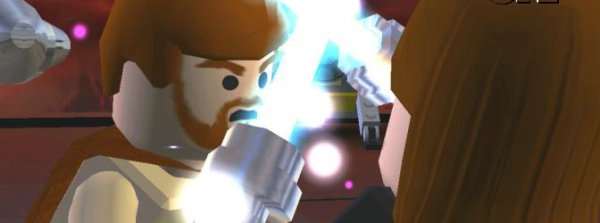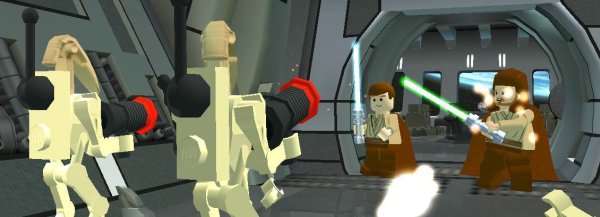Making Of: Lego Star Wars
[Lego Star Wars remains one of the most quietly radical yet enormously successful games of recent years. I've done more than one post mortem on it too. Here's a different one I did over at the Escapist. In fact, I think Jim's done at least one too. Anyway, as always, this one originated back in PC Format. The interview was performed well before the second trilogy came out.]
“We didn’t have a view necessarily on Lego or Starwars… we don’t think we ever did anything that was not Lego or not Star Wars,” says Giant's Development Director Jonathan Smith, “We were just doing Lego Star Wars. That’s what it’s it”. Sometimes these post-mortems are a story of woe, death and tears ending with an eventual bittersweet pleasure. Not so with Lego Star Wars. This is the one when everything went right.
[As a quick interjection, just after writing this article I was at the Animex festival up north, where I saw Mr Smith do a presentation to a room full of animation students about the making of the game. He was, to say the least, somewhat more expressive on what was falling apart as the game was coming together. It had me cursing him beneath my breath. The problem when a games journalist turns developer - before he went over to Development, Jonathan was one of the finest games writers of his generation - is that they know how to play the press a little too well. - Ed]
“We were actually working at Lego Company to try and take the essential quality of Lego which we had such affinity with and see if we could fulfill our belief as gameplayers, that a lot of qualities in our favourite games had something in common with our feelings for Lego,” Jonathan expounds, “By drawing from these qualities we should be able to challenge some of the conventions in the videogame world and hopefully create a Lego game that was fresh and fun. We spent a lot of time as a team of experienced videogame folks there at Lego, thinking out these ideas, experimenting with new concepts and looking at all the different possibilities that Lego gave us.”
“The challenge came from finding an imaginative landscape that we could give those abilities and deliver that experience that would be engaging for people,” Jonathan continues, “Because one of the problems with Lego is that it can seem a little abstract. The geek-attraction of it – the clinical, systemisation of it – is very beautiful, but can be cold. As we came to think about where the most exciting place for children is – where they’d be most imaginatively engaged – it was clear that there was only one universe which loomed above everything else, full of action and great characters we could bring to life in a new way…” Jayce and the Wheeled Warriors!?! “…and that was Star Wars”. Damn. Luckily, in 1999 they’d already made the first Star Wars Lego to tie in with The Phantom Menace, it had been successful and lead to a whole range. The scene was set for a game.
“That was the universe we wanted to create the game,” Jonathan describes, “Then it was simply a case of distilling the experiments we’d been doing with the ideas of Lego’s key characteristics – that it should be playable, multi-player, full of variety and surprise, accessible and non-punishing with great depth to its reward structure: pretty straight-forward stuff.” But that’s only half the story, teaming up with the “fearsomely talented individuals” at Traveller’s Tales who worked to bring the game to life over a couple of years. Since then, they’ve joined with Giant to become part of TT Games. [And since then, been bought by Warner Bros for a lot of money - Ed]
It was a game that went right. “The game was sheer delight from beginning to end,” Jonathan laughs with genuine pleasure enough to make us actually believe this audacious claim, “I’ve never been involved in a project that’s gone smoother than this one. We had terrific support right from the start from both The Lego Company and the Lucas organisation. We had a team who was working with a mature, propriety technology that they had complete mastery over – so the usual technical R&D issues which make a game creatively very difficult were overcome through the efforts of the team. To be frank, the straight-forwardness of the idea, and the directness which we approached it and the focus everyone brought to the opportunity… we knew what we wanted to do, and it was just a question of doing it. It just needed to be pursued to the end.”
The initial steps the development took were of control and setting. “We spent a lot of time on how the characters should look and move, as there had been Lego games in the past which depicted the classic mini-figure characters /as/ plastic characters, and found that as a restriction when it came to them as game characters,” Jonathan explains, “We wanted to lift all those restrictions.” Similarly, the combat system. “We were capable of creating a straight-forward combat system that felt right from the very first move,” Jonathan describes the initial successes, “We were on the right track, and then it was just going to be a question of creating more moves and polish.” “Creating the look of the world was another key thing to get right at the start… and we knew we wanted to have a world which wasn’t made of plastic, but had Lego elements that was interactive,” Johnathan continues, “To create the idea that anything in the world that was made out of Lego would be interactive, while still giving an environment that captured the drama and spectacle of the Star Wars universe.”
Lego Star Wars is best described as a family game. It was something the team pursued aggressively. “We sincerely wanted to make a game that was playable by everyone,” Jonathan says, “That meant not rejecting gamers and depth in gameplay – as we’re gamers ourselves and we had to play it for two years and wanted something to play for two years. And our children were discriminating gamers, and we wanted to create something we could be proud of at home. Accessible, but with depth.” For example, they removed the actual classical death state. You lose money, but characters could die indefinitely with no Game Over. Of course, to get the top bonuses you needed to have a load of money – but it didn’t stop you playing at any point. “That’s one of those ideas which came out of the original thinking process at Lego,” Johnathan describes its origins, “Being immersed at the culture of Lego, with 75 years of history in the art of play”.
Another attractive feature of Lego Star Wars was the co-operative mode. “Everytime you see children play it together, you can tell how important it is,” Jonathan say, “Being able to play with my children as a parent, is fantastic. Unfortunately we’ve set their expectation, and every time I give them a game which isn’t two player they often expect it to be there”. While welcome, it’s also not something which entirely made the game. Jonathan questions whether any one thing was. “Looking at from a marketing or commercial point of view, there’s probably no individual one feature you could point to which dramatically sold the game,” Jonathan notes, “it’s the collection and the whole world of play.”
While the game could be completed very quickly, the way the extras worked it demanded that you play it again, with different approaches to really see it. This means that it picked up a real gamer audience. “You’ll also find that the children took the time to progress in the game – as much as any hardcore player, and probably more,” Jonathan claims, “They may have taken them longer, but they were able to overcome the challenges as much as any other gamer. The gamer may have been more goal-orientated in driving for completion, but the younger players were no less engaged with those challenges. They tended not to have a shallow experience… but it’s important you let them enter the pool at the shallow end and help them with inflatables all the way through, to teach them how to swim. Not to stretch that metaphor too far.”
Which made Lego Star Wars a rare beast for the PC. A all-ages game based on a licence which works. Except it was never treated like just another licenced game. Perhaps that’s the key to its success. I always get slightly surprised whenever people refer to it as a game that involves licences,” Jonathan considers, “Because these were never licences to us – they were always what we are, and what we were doing. Is it Lego Star Wars? Is it us? It was always together.”





